Impact of climate change on agriculture: An Indian perspective
R.K. Prajapati1 * , S.K. Tripathi2 and R.M. Mishra1
1
School of Environmental Biology,
Awadhesh Pratap Singh University Rewa,
486 003
India
2
Departments of Energy and Environmental Sciences,
Mahatma Gandhi Chitrakoot Gramodaya Vishwavidyalaya,
Chitrakoot,
Chitrakoot
India
DOI: http://dx.doi.org/10.12944/CWE.5.1.06
India is the seventh largest country of the world. In India temperature will increase 3oC to 6oC and rainfall will increase 15-30% in 21 Centaury. While the global surface temperature is projected to increase by 1-4oC from 2100 for low emission scenario and 2.5-5.8oC for higher emission scenario in the atmosphere. This Paper has been prepared with the objects of provide key information on the impacts of climate on Indian agriculture. The greenhouses gas emissions increases day by day in the atmosphere from the many sources such as industrial sources crop production and fossil fuel combustion. These are the major sources for the climate change. The global increases in carbon dioxide concentration are due primarily to fossil fuel use and land use change, while those of methane and nitrous oxide are primarily due to agriculture. Currently Available general circulation models (GCMs) suggest that the area-averaged annual mean warming would be about 3°C in the decade of the 2050s and about 5°C in the decade of the 2080s over the land regions of Asia as a result of future increases in atmospheric concentration of greenhouse gases. In Rajasthan, a 2°C rise in temperature was estimated to reduce production of pearl millet by 10-15 per cent (Y S Ramakrishna et al.,). The state of Madhya Pradesh, where soybean is grown on 77 per cent of all agricultural land, could dubiously benefit from an increase in carbon dioxide in the atmosphere.
Copy the following to cite this article:
Prajapati R.K, Tripathi S.K, Mishra R. M. Impact of climate change on agriculture: An Indian perspective. Curr World Environ 2010;5(1):39-49 DOI:http://dx.doi.org/10.12944/CWE.5.1.06
Copy the following to cite this URL:
Prajapati R.K, Tripathi S.K, Mishra R. M. Impact of climate change on agriculture: An Indian perspective. Curr World Environ 2010;5(1):39-49. Available from: http://www.cwejournal.org/?p=1096
Download article (pdf)
Citation Manager
Publish History
Select type of program for download
| Endnote EndNote format (Mac & Win) | |
| Reference Manager Ris format (Win only) | |
| Procite Ris format (Win only) | |
| Medlars Format | |
| RefWorks Format RefWorks format (Mac & Win) | |
| BibTex Format BibTex format (Mac & Win) |
Article Publishing History
| Received: | 2010-01-29 |
|---|---|
| Accepted: | 2010-03-09 |
Introduction
The unimpeded growth of greenhouse gas emissions is raising the earth’s temperature. The consequences include the atmosphere will eventually lead to changes in the global climate, and in the climates of regions around the world, melting glaciers, more precipitation, more and more extreme weather events, and shifting seasons and ultimately will threaten to food security everywhere (IFPRI,2009). The average global surface temperature is projected to increase by 1.4-3oC from 1990-2100 for low emission scenarios and 2.5-5.8oC for higher emission scenarios of green house gases (under the new SRES ‘marker’ scenarios) in the atmosphere. The atmosphere surrounding the earth is made up of nitrogen (78%), oxygen (21%) and the remaining 1%, is made up of trace gases (called so because they are present in very small quantities) that include argon, carbon dioxide, methane and nitrous oxide. These gases also called greenhouse gases act as a blanket and trap heat radiating from the earth and make the atmosphere warm. Climate change, also called global warming, refers to the long-term fluctuations in temperature, precipitation, wind and other elements of the Earth’s climate system. The Intergovernmental Panel on Climate Change (IPCC), established jointly by the World Meteorological Organization (WMO) and the United Nations Environment Program (UNEP), in 1988, has been mandated to assess all available factual information on the science, the impacts, and the economies of climate change and on the adaptation/ mitigation options to address climate change. Since the Earth Summit in Rio in 1992, it has been a long march for the world to reach a consensus and to commit together, on the road to action in combating global warming. The first international approach to climate change had taken shape with the development of the United Nations Framework Convention on Climate Change (UNFCCC). Adopted in 1992, the UNFCCC set a framework for action aimed at stabilization of greenhouse gas (GHG) concentrations, in the atmosphere at a level that would prevent dangerous anthropogenic interference with the climate system. The first Conference of the Parties to the Convention (COP-1) was held in Berlin in March - April, 1995. During the COP-1, it became clear to the world community that ‘Rio is not enough’ and pressed for adequacy of commitment by the developed countries for reduction of GHGs emissions. Accordingly, a Protocol to the Climate Change Convention was adopted in Kyoto in 1997, now known as the Kyoto Protocol. The objective of the Kyoto Protocol is aimed at bringing down the global GHG emissions by 5.2 % during the year 2008-2012 (Sengupta, 2002).
The United Nations Climate Change Conference in Copenhagen, Denmark took place from 7-19 December 2009. It included the fifteenth Conference of the Parties (COP 15) to the United Nations Framework Convention on Climate Change (UNFCCC) and the fifth Conference of the Parties serving as the Meeting of the Parties to the Kyoto Protocol (COP/MOP 5). In the end, the Copenhagen conference, under the aegis of the United Nations, produced such a diluted result that not many among the 192 countries present — reflecting the biggest gathering of summiteers on record — were ready to lend it endorsement. Thus, officially the meet agreed only to “take note” of what had transpired. Calling the final outcome the “Copenhagen Accord” is egregious. What is being passed off as an accord representing all those present is, in fact, nothing more than a convenient agreement between the US and the Basic (Brazil, South Africa, India and China) countries with which some industrialized and some developing nations can be brought in line. Copenhagen has produced a strange result (Asian Age, 2009). As final nations agreed to corporate in reducing emissions, “ with a view” to scientists warnings to keep temperature from rising more than 2 degrees Celsius (3.6 degrees F) above preindustrial levels, that , is , 1.3 degrees C above today’s average temperatures. Developing nations will report every two years on their voluntary actions to reduce emissions. Those reports would be subjects to “international consultations and analysis”- a concession by China to the US. One positive feature of Copenhagen is the US promise to arrange for $30 billion in three years and $100 billion after 2020 with which developing countries may address climate change problems (Daily News, 2009).
The global increases in carbon dioxide concentration are due primarily to fossil fuel use and land use change, while those of methane and nitrous oxide are primarily due to agriculture. As a result we are witnessing global warming. Continuing emissions of greenhouse gases from human activities are likely to result in significant changes in mean climate and its intraseasonal and inter annual variability in the Asian region. Given the current state of climate modeling, projections of future regional climate have only limited confidence. According to the IPCC business-as-usual (BAU) scenario (scenario A), it is expected that the average global surface temperature may rise by 0.2 to 0.5°C per decade during the future if human activities which cause greenhouse gas emissions continue unabated (IPCC, 1990).
Currently Available general circulation models (GCMs) suggest that the area-averaged annual mean warming would be about 3°C in the decade of the 2050s and about 5°C in the decade of the 2080s over the land regions of Asia as a result of future increases in atmospheric concentration of greenhouse gases. Under the combined influence of greenhouse gas and sulfate aerosols, surface warming would be restricted to about 2.5°C in the 2050s and about 4°C in the 2080s. The globally hot spots of key future climate impacts vulnerabilities in Asia are indicated in figure 1. According to this impacts on India as the gross per capita water availability in India will decline from ~1820 M3/yr in 2001 to as low as ~ 1140 M3/yr in 2050. Increase coastal water temperatures would exacerbate the abundance/ or toxicity of cholera in south Asia and in East Asia for 10C rises in surface air temperature expected by 2020s, water demand for agriculture irrigation would increase by 6-10% or more (IPCC, 2007).
The Fourth Assessment Report of the Intergovernmental Panel on Climate Change (IPCC 2007) emphatically shows that the Earth’s climate is changing in a manner unprecedented in the past 400,000 years. By the end of 2100, the mean planet wide surface temperatures will rises by 1.4–5.8°C, precipitation will decrease in the sub-tropics, and extreme events will become more frequent (IPCC 2007, WG-III). However, changes in climate are already being observed – the last 60 years were the warmest in the last 1000 years and changes in precipitation patterns have brought greater incidence of floods or drought globally.
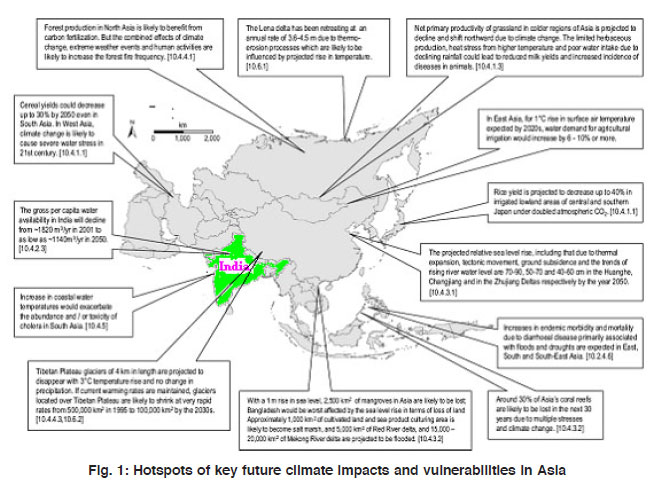 |
Figure 1: Hotspots of key future climate impacts and vulnerabilities in Asia Click here to view figure |
Indian Scenario of Climate Change
Analysis done by the some governmental and non governmental bodies on this issues and indicated the Indian climate found the same trends as floods, drought, and temperature from over the past 100 years rises but there are some regional patterns. Areas of increasing trend in monsoon rainfall are found along the west coast, north Andhra Pradesh and north-west India, and those of decreasing trend over east Madhya Pradesh and adjoining areas, north-east India and parts of Gujarat and Kerala (-6 to -8% of normal over 100 years). Surface air temperature for the period 1901 – 2000 indicates a significant warming of 0.4°C for 100 years. In the 21st century rainfall will increase by 15 – 31%, and the mean annual temperature will increase by 3°C to 6°C. The warming is more pronounced over land areas, with the maximum increase over northern India. The projections are average of six general circulation model (GCM) predictions for climate change as temperature and precipitation pattern over the year detected (cline, 2007) for different regions of the country indicate in table 1 and The world Resources Institute estimates of GHG emissions from the world, India as a whole and Indian agriculture. Agricultural practices account for about 20 percent of India’s total emissions; thus, cost-effective reductions in emissions from crop agriculture could significantly reduce India’s total emissions (Table 2).
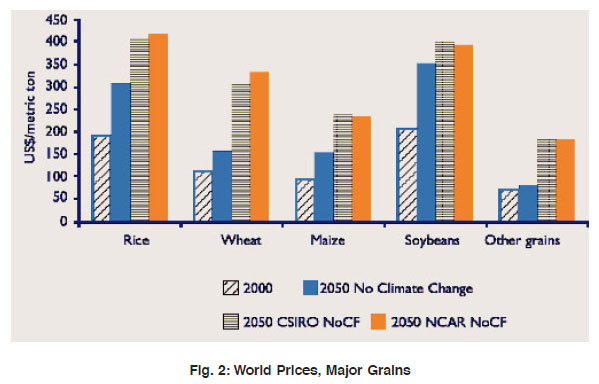 |
Figure 2: World Prices, Major Grains Click here to view figure |
Impacts of Climate Change
The sources of the IPCC estimates are the three different GCMs, reflecting four different scenarios for estimating climate change impact on grain production.
First Scenario
Disregards any adjustments that farmers might make to offset the impacts of climate change on grain production, and disregard the effects on production of an atmosphere richer in CO2. (CO2 is essential to plant growth, and much experimental work shows that higher concentrations of it in the atmosphere in fact stimulate such growth);
 |
Table 1: Climate change: India Click here to view table |
Second Scenario
Incorporates the CO2 enriching effect on growth;
Third Scenario
Includes both the CO2 enriching effect and the effect of modest adjustments that farmers could make using currently known practices, for example, shifting to a different variety of the same crop and changing the planting date by less than one month in response to a change in the length of the growing season;
 |
Table 2: Greenhouse gas emissions, 2004 estimates (million mt, COe) Click here to view table |
Fourth Scenario
Includes the CO2 effect on growth, the modest adjustments to farming just mentioned, as well as more ambitious adjustments, such as shifting to an entirely different crop, changing the planting date by more than one month, and using more irrigation (Crosson, 1997).
Climate-related disasters have brought widespread misery and huge economic losses to India, adversely affecting public health, food security, agriculture, water resources and biodiversity. The situation is likely to worsen if human beings continue to pump ‘greenhouse gases’ (GHGs) like carbon dioxide into the atmosphere.
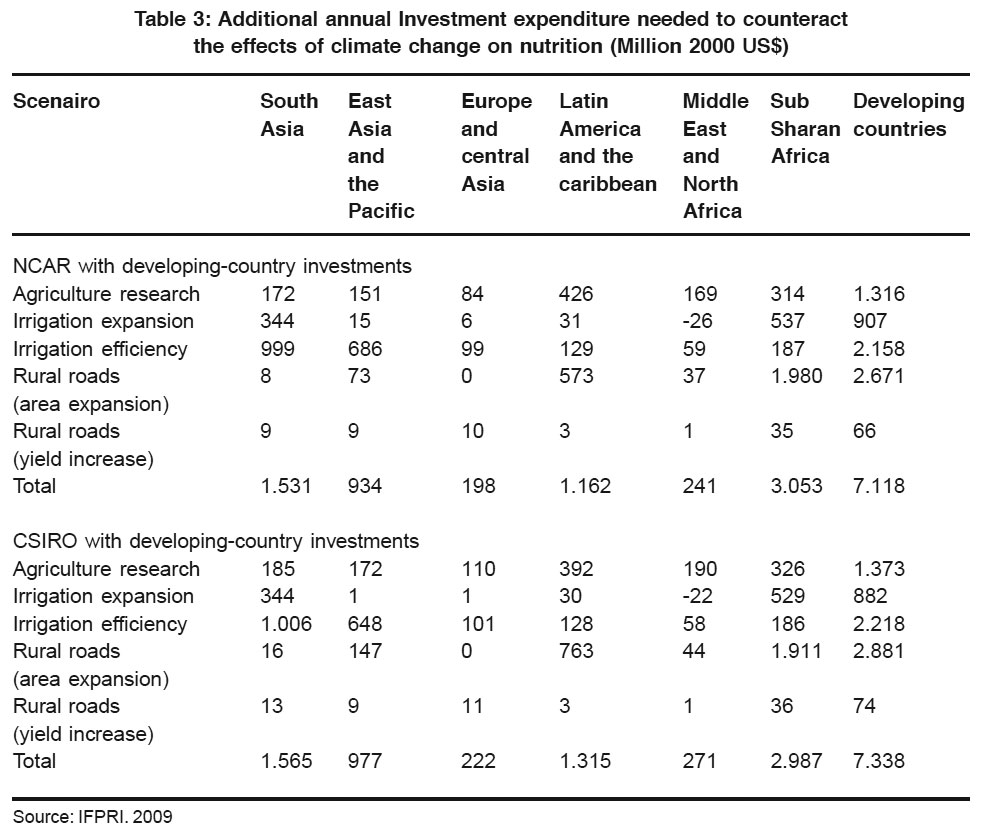 |
Table 3: Additional annual Investment expenditure needed to counteract the effects of climate change on nutrition (Million 2000 US$) Click here to view table |
The additional annual investments needed to return the child malnutrition numbers to the no climate-change results are $7.1 billion under the wetter National Center for Atmospheric Research, (NCAR) scenario and $7.3 billion under the drier Commonwealth Scientific and Industrial Research Organization (CSIRO) scenario indicated in table 3. Sub-Saharan African investment needs dominate, making up about 40 percent of the total. Of that amount, the vast majority is for rural roads. South Asia investments are about $1.5 billion per year, with Latin America and the Caribbean close behind with about $1.2 to $1.3 billion per year. East Asia and the Pacific needs are just under $1 billion per year. Agricultural research is important in all three of these regions, as are irrigation investments. Unlike Sub-Saharan Africa, road investments in these regions are relatively small. With additional investments in developed countries, spillover effects to the developing world reduce the need for adaptation investments slightly. For example, with the NCAR scenario, the annual investment need is $7.1 billion if productivity expenditures are only in the developing world. With developed-country productivity investments, that amount drops to $6.8 billion. Demonstrate world price effects for major grains, respectively, assuming no CO2 fertilization Figures 2 (IFPRI, 2009). With no climate change, world prices for the most important agricultural crops—rice, wheat, maize, and soybeans will increase between 2000 and 2050, driven by population and income growth and biofuels demand. Even with no climate change, the price of rice would rise by 62 percent, maize by 63 percent, soybeans by 72 percent, and wheat by 39 percent. Climate change results in additional price increases—a total of 32 to 37 percent for rice, 52 to 55 percent for maize, 94 to 111 percent for wheat, and 11 to 14 percent for soybeans. If CO2 fertilization is effective in farmers’ fields, these 2050 prices are 10 percent smaller. The growth rate of rice cultivation area in select Asian countries are depicts in table 4(FAOa, 1999). Current rates of land degradations u ggest that a further 1.8 million km² of farmland could become unproductive in Asia by 2050, adding stress to a system that must ensure food security in the context of a rapidly growing population.
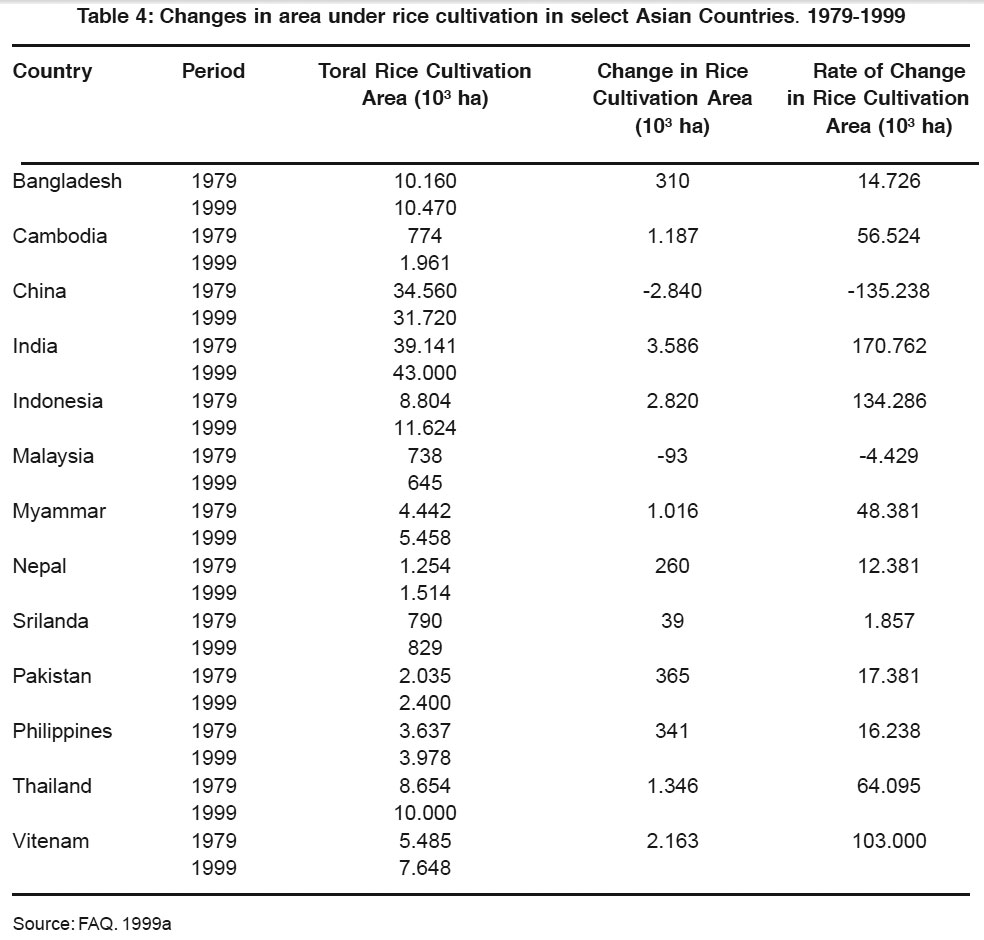 |
Table 4: Changes in area under rice cultivation in select Asian Countries. 1979-1999 Click here to view table |
Indian Agriculture and Climate Change
India is the seventh largest country in the world and the second largest in Asia, has a total geographical area of 329 Mha, of which only 305 Mha is the reporting area (the area as per the land records of villages and towns). The mainland stretches from 8°4' N to 37°6' N and 68°7' E to 97° 25' E. It has a land frontier of 15,200 km and a coastline of 7,516 km. Agriculture is extremely vulnerable to climate change. Higher temperatures eventually reduce yields of desirable crops while encouraging weed and pest proliferation. Changes in precipitation patterns increase the likelihood of short-run crop failures and long-run production declines (IFPRI, 2009). The IPCC estimates that the global technical mitigation potential for agriculture (excluding forestry) will be between 5500 and 6000 Mt CO2-equivalent per year by 2030, 89 percent of which are assumed to be from carbon sequestration in soils. The scientist predicted the impact of climate changes on the Indian agriculture, the Indian agriculture mostly dependent on the rainfall for the irrigation. Any change in rainfall patterns poses a serious threat to agriculture, and therefore to the country’s economy and food security. The crop model indicates that in South Asia, average yields in 2050 for crops will decline from 2000 levels by about 50 percent for wheat, 17 percent for rice, and about 6 percent for maize because of climate change. With climate change, average calorie availability in Asia in 2050 is expected to be about 15 percent lower and cereal consumption is projected to decline by as much as 24 percent compared to a no climate change scenario (IFPRI, 2009).
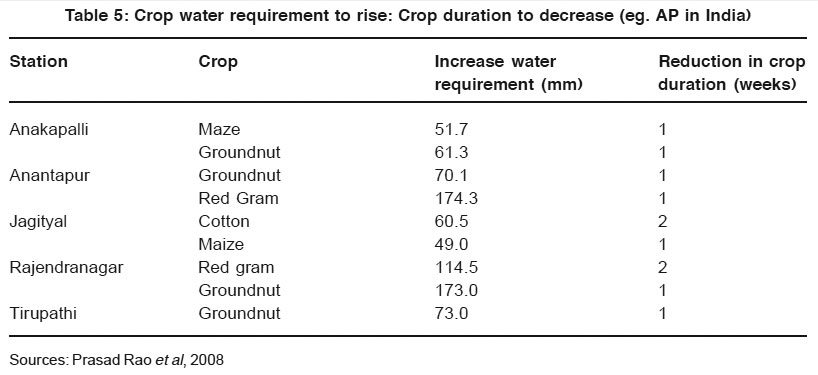 |
Table 5: Crop water requirement to rise: Crop duration to decrease (eg. AP in India) Click here to view table |
Semi-arid regions of western India are expected to receive higher than normal rainfall as temperatures soar, while central India will experience a decrease of between 10 and 20 per cent in winter rainfall by the 2050s. (M Lal et al., 2001) increased temperatures will impact agricultural production. Higher temperatures reduce the total duration of a crop cycle by inducing early flowering, thus shortening the ‘grain fill’ period. The shorter cycle of the crop will be reducing the crop yield per unit area as shown in table 5. Yield reductions of irrigated crops due to water stress are directly estimated in the hydrology portion of IMPACT, taking into account the growing demand for water outside agriculture as well as agricultural demands. As expected, irrigated yield losses due to water stress are relatively higher under the CSIRO scenario than the NCAR scenario. For example, in East Asia and the Pacific, with no climate change, the combined effects of nonagricultural demand growth and increased irrigated area result in an average 4.8-percent decline in irrigated rice yields (IFPRI, 2009) Table 6. Report the climate change factors and Maize yield in India.
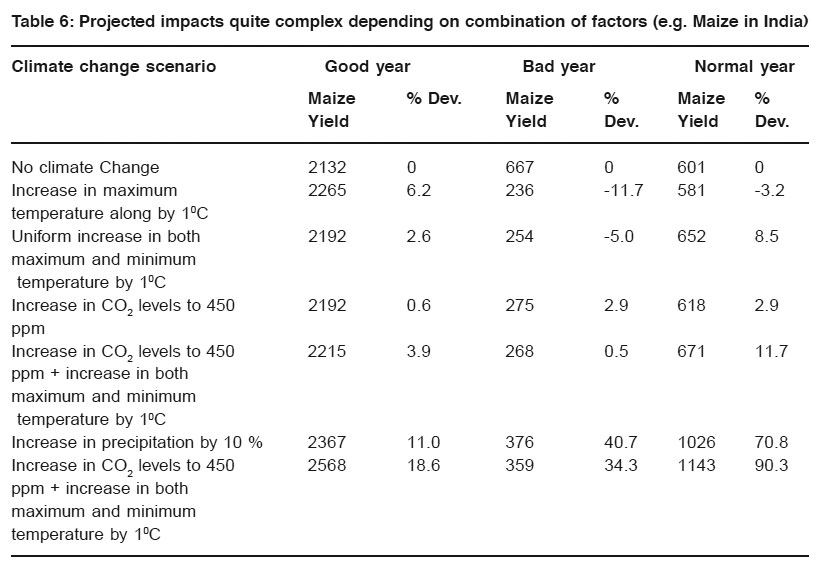 |
Table 6: Projected impacts quite complex depending on combination of factors (e.g. Maize in India) Click here to view table |
In India the direct impact of climate change would effect plant growth, development and yield due to changes in rainfall and temperature. Increase in temperature would reduce crop duration, increase crop respiration rates, change the pattern of pest attack and new equilibrium between crops and pests hasten mineralization in soils and decrease fertilizer use efficiency. All these could considerably affect crop yields in long run. In general the simulation results indicate that increasing temperature and decreasing solar radiation levels pose a serious threat in decreasing growth and yield of agricultural crops. Increased CO2 levels. Agriculture will be adversely affected not only by an increase or decrease in the overall amounts of rainfall, but also by shifts in the timing of the rainfall. For instance, over the last few years, the Chhattisgarh region has received less than its share of pre-monsoon showers in May and June. These showers are important to ensure adequate moisture in fields being prepared for rice crops (Y S Ramakrishna et al,). Agriculture will be worst affected in the coastal regions of Gujarat and Maharashtra, where agriculturally fertile areas are vulnerable to inundation and salinisation (Karen O’Brien et al., 2001). Standing crop in these regions is also more likely to be damaged due to cyclonic activity. In Rajasthan, a 2°C rise in temperature was estimated to reduce production of pearl millet by 10-15 per cent (Y S Ramakrishna et al.,). The state of Madhya Pradesh, where soybean is grown on 77 per cent of all agricultural land, could dubiously benefit from an increase in carbon dioxide in the atmosphere. According to some studies, soybean yields could go up by as much as 50 per cent if the concentration of carbon dioxide in the atmosphere doubles. However, if this increase in carbon dioxide is accompanied by an increase in temperature, as expected, then soybean yields could actually decrease. If the maximum and minimum temperatures go up by 1°C and 1.5°C respectively, the gain in yield comes down to 35 per cent. If maximum and minimum temperatures rise by 3°C and 3.5°C respectively, then soybean yields will decrease by five per cent compared to 1998 (M Lal et al., 1999).Changes in the soil, pests and weeds brought by climate change will also affect agriculture in India (TERI, 2002).For instance, the amount of moisture in the soil will be affected by changes in factors such as precipitation, runoff, and evaporation (Anon, 2000).
Mitigation of Greenhouse gas emission
There are some approaches to control or mitigation of greenhouse gases Recommendation in National Conference on Climate Change and Indian Agriculture 12-13 October 2007. Which are as follows:-
- Improve inventories of emission of greenhouse gases using state of art emission equipments coupled with simulation models, and GIS for up scaling
- Evaluate carbon sequestration potential of different land use systems including opportunities offered by conservation agriculture and agro-forestry
- Critically evaluate the mitigation potential of biofuels; enhance this by their genetic improvement and use of engineered microbes
- Identify cost-effective opportunities for reducing methane generation and emission in ruminants by modification of diet, and in rice paddies by water and nutrient management. Renew focus on nitrogen fertilizer use efficiency with added dimension of nitrous oxides mitigation
- Assess biophysical and socio-economic implications of mitigation of proposed GHG mitigating interventions before developing policy for their implementation
Conclusion
Identifies climate change as one of the greatest challenges of our time and emphasizes strong political will to urgently combat climate change in accordance with the principle of common but differentiated responsibilities and respective capabilities. India is the seventh largest country of the world. In India temperature will increase 3oC to 6oC and rainfall will increase 15-30% in 21 Centaury. While the global surface temperature is projected to increase by 1-4oC from 2100 for low emission scenario and 2.5-5.8oC for higher emission scenario in the atmosphere. World prices for most important agriculture such as the prices of rice would rise by 62 percent, maize by 63 percent soybeans by 72 percent and wheat by 39 percent. Climate change will adversely affect Kharif crops than rabi crops. In India direct impact of climate change would effect plant growth, developmental and yield due to changes in rainfall and temperature.
References
- Ramakrishna, Y.S. et al, Impacts of climate change scenarios on Indian agriculture: Evidenc.es, Central Research Institute for Dryland Agriculture, Hyderabad, p 6
- Ramakrishna, Y. S. et al, Impacts of climate change scenarios on Indian agriculture: Evidences, Central Research Institute for Dryland Agriculture, Hyderabad, p 3.
- Nelson, Gerald. C., Robertson, Richard., Msangi, Siwa., Zhu , Tingju., Liao, Xiaoli., Jawajar, Puja., Greenhouse gas mitigation issues for Indian agriculture, International food policy Research Institute, Washington DC, USA (2009)
- Sengupta, B. Parivesh Climate change, A News Letter from ENVIS Centre- Central Pollution control Board New Delhi, Oct. 2002, http://cpcbenvis.nic.in/newsletter/globel/ contents.html, (last Assessed, 22 Dec. 2009) (2002)
- Anon, Climate and climate change in India,http://www.brown.edu/Research/EnvStudies_Theses/full9900/creid/ climate_and_climate_change_in_in.htm, (last accessed Dec. 20, 2009) (2000)
- IPCC, Climate change: the IPCC Scientific Assessment. WMO/UNEP, Intergovernmental Panel of Climate change. Cambridge University Press, Cambridge, UK (1990)
- Cruz, R.V., H. Harasawa, M. Lal, S. Wu, Y. Anokhin, B. Punsalmaa, Y. Honda, M. Jafari, C. Li and N. Huu Ninh., Asia. Climate Change 2007: Impacts, Adaptation and Vulnerability. Contribution of Working Group II to the Fourth Assessment Report of the Intergovernmental Panel on Climate Change, M.L. Parry, O.F. Canziani, J.P. Palutikof, P.J. van der Linden and C.E. Hanson, Eds., Cambridge University Press, Cambridge, UK, (2007) 469-506.
- Crosson, Pierre. Impacts of Climate Change on Agriculture, Resources for the future, Washington DC, www.rff.org/RFF/ Documents/RFF-CCIB-04.pdf. (last assessed Dec. 10, 2009) (1997)
- G.S.L.H.V Prasada Rao and Pushpalatha, P. B. Impact of climate variability on quality of produce in plantation crops. Proceedings of National seminar on Climate Changes- Its Impact on Different Sectors in India, V.S.R and N.V.R. College, Tenali p. (2008) 35-38.
- Gerald, C., Nelson, Mark. W., Rosegrant, Jawoo. Koo., Richard, Robertson., Timothy, Sulser., Tingju, Zhu., Claudia, Ringler., Siwa, Msangi., Amanda, Palazzo., Miroslav, Batka., Marilia, Magalhaes., Rowena, Valmonte-Santos., Mandy, Ewing., and David, Lee. Climate change, Impact on Agriculture and Costs of Adaptation, International food policy Research Institute, Washington DC, USA (2009)
- William, R. Cline., Global Warming and Agriculture: Impact estimates by Country, Centre for global Development, Washington DC (2007)
- Smith, P. D., Martino, Z., Cai, D., Gwary, H., Janzen, P., Kumar, B., McCarl, S., Ogle, F. O., Mara, C. Rice, B., Scholes, O. Sirotenko, Agriculture. In Climate Change 2007: Mitigation. Contribution of Working Group III to the Fourth Assessment Report of the Intergovernmental Panel on Climate Change [B. Metz, O.R. Davidson, P.R. Bosch, R. Dave, L.A. Meyer (eds)], Cambridge University Press, Cambridge, United Kingdom and New York, NY, USA. (2007)
- World Resources Institute. Climate analysis indicators tool (CAIT) 6.0. Washington, DC: World (2009)
- FAO, 1999a: Production Yearbook, Food and Agriculture Organization of the United Nations, Rome, Italy (1999)
- Lal, M. et al., Future climate change: Implications for Indian summer monsoon and its variability, in Current Science, Vol 81, No 9, November 10, (2001) p 1205
- M Lal et al., Growth and yield responses of soybean in Madhya Pradesh, India to climate variability and change, Agricultural and Forest Meteorology 93, Elsevier Science, (1999) pp 65-66
- Impact of Climate change: Western and Central India: Fact sheet, www.cseindia.org/ programme/geg/pdf/western.pdf, (last Assessed Dec. 22, 2009).
- Karen, O., Brien et al., The dynamics of vulnerability to global change, http:// www.ihdp.uni-bonn.de/IHDPUpdate0102/ article4.html (Online Assessed Dec. 20, 2009) (2001)
- National Conference on Climate Change and Indian Agriculture 12–13 October, at New Delhi, http://www.climatechallengeindia.org/Download-document/68-National - Conference-on-Climate-Change-and-Indian Agriculture, (last Assessed Dec. 10, 2009) (2007)
- National Conference on Climate Change and Indian Agriculture 12–13 October, Organized by IARI, New Delhi. http:// www.climatechallengeindia.org/Download-document/68-National-Conference-on-Climate-Change-and-Indian-Agriculture, (last Assessed Dec. 23, 2009) (2007)
- Singh, Anil Kumar, Options on crop production for coping with climate change in South Asia, Proceeding at International Symposium on climate change and food security in South Asia, Dhaka, Bangladesh, 28-29 August 2008, http://www.wamis.org/ agm/meetings/rsama08/S507-Singh- FAO.pdf. (last Assessed Dec. 20, 2009) (2009)
- Tata Energy Research Institute, India specific impacts of climate change, http:// www.teriin.org/climate/impacts.htm, (last Assessed Dec. 20, 2009) (2002)
- The Asian Age, Copenhagen: Where it failed, http://www.asianage.com/presentation/ leftnavigation/opinion/editorial/copenhagen-where-it-failed.aspx, (last Assessed Dec. 22, 2009) (2009)






